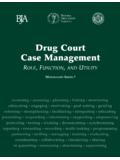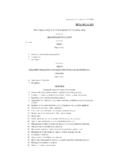Transcription of DETERMINING THE COST-EFFECTIVENESS OF UTILITY LATE …
1 DETERMINING THE COST-EFFECTIVENESS . OF. UTILITY LATE PAYMENT CHARGES. PREPARED BY: Roger D. Colton Fisher, Sheehan and Colton Public Finance and General Economics 34 Warwick Road Belmont, MA 02478. 617-484-0597. July 1994. Utilities often seek to impose a late payment charge on those households who do not pay \1\. by a designated due date. The imposition of such a charge is generally designed to serve either of two purposes: (1) to compensate the UTILITY for expenses incurred as a result of the \2\. late payment; or (2) to provide an incentive for households to make timely payments. Unfortunately, not only do UTILITY late payment charges often bear little relation to these two stated purposes, but, in overcharging in cases of delinquent payments, utilities often create other adverse impacts. The purpose of this memo is to examine the elements which go into a determination of whether a late payment charge is justified.
2 The memo is divided into three parts. Part I. defines the differing types of late payers. Part II looks at the late payment charge designed to compensate the UTILITY for the expenses associated with delinquencies. Part III examines the rationality of a late payment charge designed to serve as an inducement for prompt payment. Before looking at the specific late payment charges, however, it is necessary to delineate the type of customers which are likely to be involved. I. DEFINING THE LATE PAYER: WHY PEOPLE DON'T PAY ON TIME. \3\. To prevent discrimination in the collection of late payment charges, a UTILITY must recognize \4\. the differences which exist between habitual nonpayers. Nonpayers can be categorized into three primary groups. Households who do not pay because they can not pay represent the first group.
3 These households are typified by extremely low-incomes and high bills as a \5\. percentage of their income. These households simply have insufficient funds to pay their bills. The 1989 NCLC study The Forgotten Crisis, for example, found that in 10 of the 16. states which collect and report income on LIHEAP recipients, after paying their winter home \1\. The name given to these charges does not change their nature. They may be called late payment charges, forfeited discounts, a "net" bill versus a "gross"bill, a penalty and the like. Moreover, there is no conceptual difference between the promise of a lower bill for prompt payment and the threat of a higher bill for late payment. \2\. But see, section , page 8, infra. \3\. See, Coffelt v. Arkansas Power and Light Company, 451 881, 882 (Ark. 1970). \4\. See, Jones v.
4 Kansas City Gas and Electric Co., 565 597, 606 (Kan. 1977); see also, Guste v. Council of New Orleans, 297 518 (La. Ct. App. 1974), rev'd, 509 290 (1975). \5\. One study in Philadelphia found that while customers below 150 percent of poverty, who heat with natural gas, spent percent of their income on their gas bill, customers at or above 150 percent of poverty, who heat with natural gas, spent percent. Direct Testimony and Exhibits of Eunice Grier, In Re. Philadelphia Gas Works, presented on behalf of the Public Advocate (June 1989). According to the Energy Information Administration of the Department of Energy, nationwide, while all households heating with natural gas spent on average six (6) percent of their income on their gas bills, households with income less than $5,000 spent 25 percent and households with income of $5,000 - $10,000 spent 13 percent.
5 Similarly, DOE reported, households at or below 100 percent of poverty, who heating with natural gas, spent 19 percent of their income on their gas bill, while households at or below 125 percent of poverty spent 16 percent. Department of Energy, Energy Information Administration, Residential Energy Consumption Survey: Consumers and Expenditures, April 1984 through March 1985, Part I: National Date (1987). heating bills, these recipients had less than $75 per week left for all other household expenses, including housing, food, transportation, medical care, clothing and telephone \6\. service. To put this figure in perspective, national figures indicate that, on average, low- income households spend $67 per week on food alone, $60 per week on housing alone \7\. (excluding energy) and $39 per week on transportation.
6 Households who experience an ongoing mismatch between their UTILITY cycle billing date and their receipt of public assistance comprise a second group of habitual late payers. A. household in this group might, for example, receive a UTILITY bill due on the 15th of each month but not receive its Social Security check until the 20th. In such instances, while all monthly payments are likely made, they are routinely made after the due date. The potential for this class to be sizeable is great. Households who depend on public benefit programs such as SSI, AFDC, Social Security and the like not only have no control over the date on which they receive their income. Moreover, they do not have sufficient funds on a month-to-month basis to be able to set aside some amount for a contingent future liability such as a UTILITY bill in the next month.
7 These households live check-to-check. Households who use late payment as a money management technique comprise the third and final group of chronic late payers. In these cases, so long as the return on the funds not paid to the UTILITY exceeds any resulting late payment charge, the customer will financially benefit from delaying payment as long as possible. These households are not likely to be low-income households. Households making this type of sophisticated financial calculation \8\. are not likely to include those households lacking in education. Each of these different classes creates different issues for assessing the efficacy and reasonableness of a late payment charge. Accordingly, the implications of each will be assessed throughout the discussion below. II. THE LATE PAYMENT CHARGE AS COMPENSATION FOR EXPENSES.
8 The primary purpose of a UTILITY late payment charge is to compensate the UTILITY for expenses associated with delinquent payments. A customer's delinquent payment of her UTILITY bill can result in two types of expenses to the company. The UTILITY may first experience out-of-pocket expenses. A second expense involves the carrying charge associated with delinquent payments. A UTILITY is entitled to compensation for each. A. COMPENSATION FOR OUT-OF-POCKET EXPENSES. Late payments by UTILITY customers can create out-of-pocket expenses for the UTILITY . These \6\. National Consumer Law Center, Energy and the Poor: The Forgotten Crisis (May 1989). \7\. Id. \8\. Compare, National Assessment of Educational Achievement, Mathematics Report No. 04-MA-02 (1975). Page 2 Fisher, Sheehan and Colton October 21, 1998 Public Finance & General Economics 34 Warwick Road, Belmont, MA 02178.
9 617-484-0597 -- 617-484-0594 (FAX). expenses might include, for example, the postage associated with delivering reminder notices or shutoff notices, the costs of telephone calls to make "personal contact" prior to a shutoff, and the cost of fuel used in making a premise visit to disconnect service. In seeking compensation for out-of-pocket expenses, it is as important to determine how to collect these expenses as it is to determine when to collect them. 1. The Level of the Late Payment Charge. A late payment charge designed to compensate a UTILITY for out-of-pocket collection expenses should be based on the decremental cost of collection to the UTILITY . In this fashion, the UTILITY will be compensated for those costs, but only for those costs, that are incurred as a result of the late payment. A decremental cost is the cost that the UTILITY would save should one late payment instead be made in a timely fashion.
10 Historically, most late payment charges have been based on a fully-embedded cost analysis. This type of analysis posits that if, for example, a UTILITY staffmember spends 1/4. hour on a delinquent account, and the UTILITY staff salary is $4 per hour, the delinquent account has " cost " the UTILITY $1. The embedded cost analysis, in other words, assigns an expense to the collection function and per se ascribes the cause of that expense to the collection activity. A decremental cost analysis approaches the issue in a somewhat different manner. The decremental analysis first calculates total UTILITY costs with the late payment. The analysis next calculates total UTILITY costs without the late payment. Only the difference is then assigned to the late payment charge. In this case, if the UTILITY uses existing staff for collection, a not uncommon occurrence, the late payment imposes no decremental cost on \9\.






